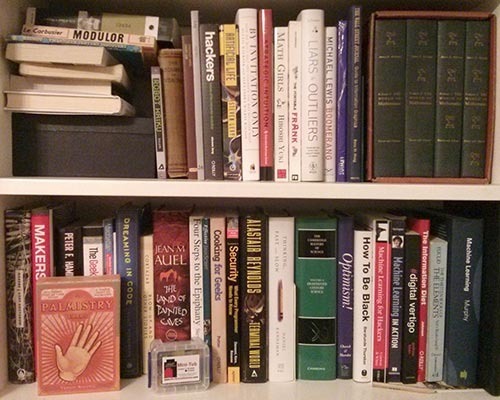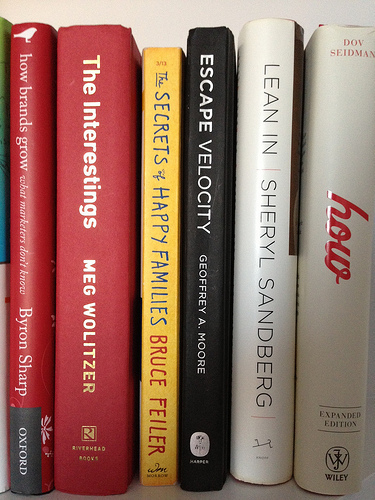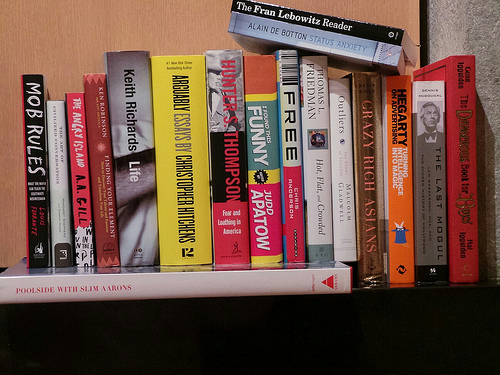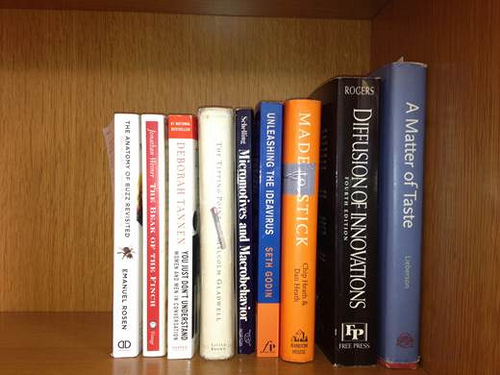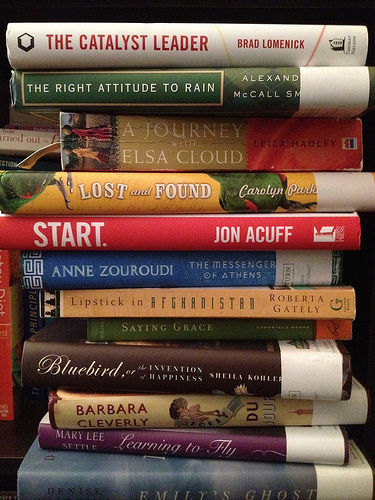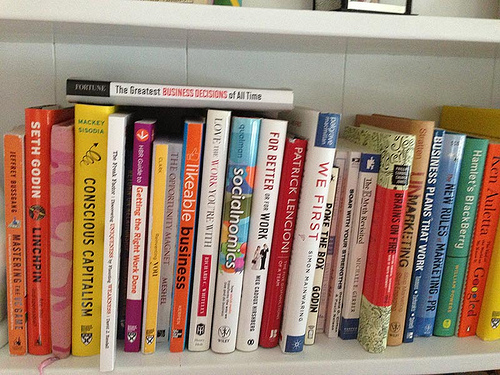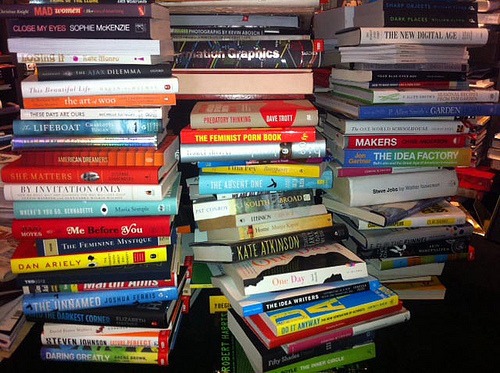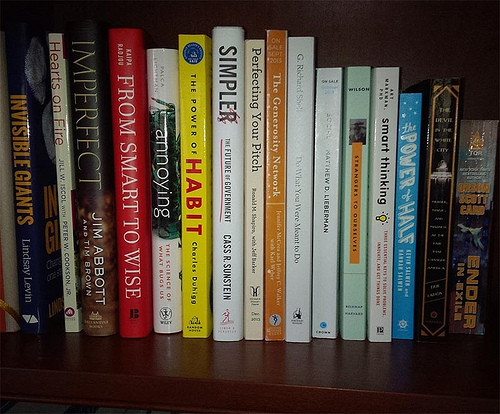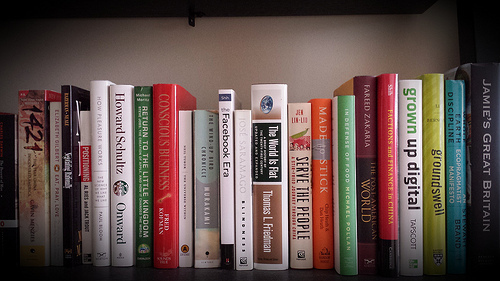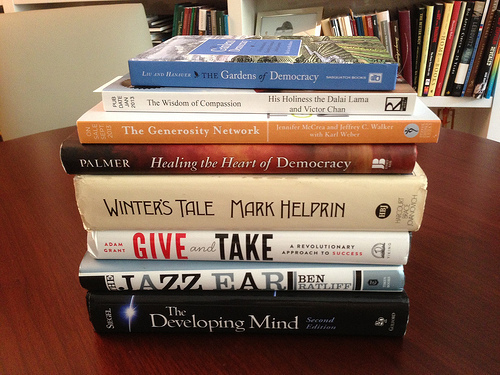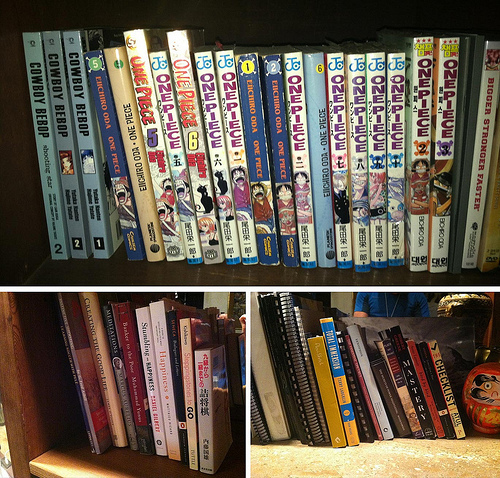Timothy Ferriss's Blog, page 107
November 26, 2013
Premiere TV Episode! “The Tim Ferriss Experiment” — Online for Free
You asked, and I heard you.
To those outside of the US, and to those of you who don’t own TVs — we’ve done two things:
- All episodes of The Tim Ferriss Experiment will be available on iTunes.
– The first full episode is entirely free and available everywhere online! This includes…
iTunes (highest resolution, fastest load times) — Please watch here and leave a review! Pretty please.
Xbox
PlayStation
Amazon Instant
Google Play
Upwave brand site
YouTube — Again, would really appreciate the views and reviews on iTunes, if possible.
Just for this post, I’ve disabled comments below. Please let me know what you think of Episode One on this page! This has been a labor of love, and I hope you enjoy it.
ALSO: For the TV premiere — 8pm ET (5pm PT) this Sunday on HLN — I will be live tweeting (#TFX) from about 7:30-9pm ET (4:30pm-6pm PT), including Q&A, giveaways, and behind-the-scenes goodies. Please join me!
Much more to come… 






November 11, 2013
The Tim Ferriss Book Club Launches — Book #1: Vagabonding
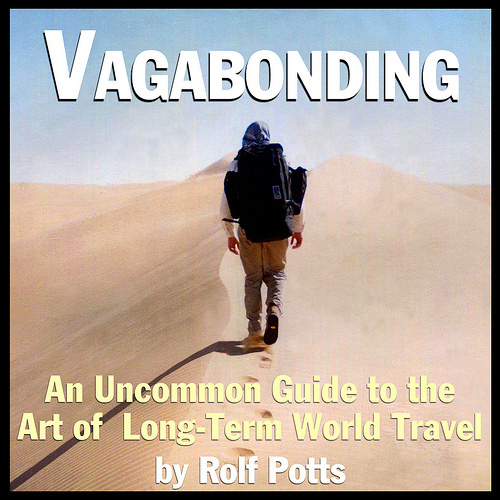
The book Vagabonding traveled with me around the globe for 18 months.
This post is a dream come true.
Starting in college, I’ve fantasized about somehow driving fantastic but under-appreciated books into the limelight. I have a soft spot for out-of-print tomes and niche publications.
Flash forward, nearly 15 years later…
After three #1 bestsellers, I’ve finally pulled the trigger. For the last several months, I’ve been quietly buying audiobook and e-book rights to books that have changed my life, and producing audiobooks in professional studios.
Fun!
This post launches the Tim Ferriss Book Club, and the first book is incredible: Vagabonding.
Why a Book Club?
There are several reasons…
I was greatly influenced by books recommended by Oprah Winfrey’s Book Club (e.g. Love in the Time of Cholera), despite the fact that I wasn’t her demographic.
I could never find a book club for 20-40-year old males, or a curator for that demo. I’m now in a position to give it a shot myself (and extend it to women, of course).
Based on recent experiments (BitTorrent and elsewhere), I think I can at least double an author’s print sales with my marketing of their audio/e-book. I like helping good writers.
This blog’s community is incredible…and we like books (see comparison to TV and NYT Op-Ed impact). The idea of having thousands of people read the same book each month, all interacting with one another and the book’s author, is thrilling to me. And, last but not least…
You’ve asked me to start a book club for years!
The time has come.
This leads us to Rolf Potts and a little tome with a huge impact…
Why Vagabonding?
“Vagabonding packs a serious philosophical punch and has a cult-like following among independent travelers…”
— The Oregonian
“This book will become a travel classic, and belongs in all travel collections.”
— Library Journal
Starting in 2004, I traveled the world for roughly 18 months. The lessons learned formed the basis for much of The 4-Hour Workweek.
On my journey — from the back alleys of Berlin to the hidden lakes of Patagonia — I had next to nothing: one suitcase, one backpack, and only two books. One of those books was Walden by Henry David Thoreau (naturally), and the other was Vagabonding: An Uncommon Guide to the Art of Long-Term World Travel, written by Rolf Potts.
Since 2005, I’ve continued to read 1-3 books per week on average, or 50-150+ books a year.
Vagabonding easily remains in my top-10 list for life-changing books. Why? Because one incredible trip, especially a long-term trip, can change your life forever. And Vagabonding teaches you how to travel (and think), not for one trip, but for the rest of your life. Tim Cahill, founding editor of Outside magazine and a brilliant travel writer himself, has said of Vagabonding, “I think this is the most sensible book of travel related advice ever written.”
In my own dog-eared copy of Vagabonding, I have notes, underlines, and highlights on practically every page, ranging from the tactical (how to pack intelligently, what to bring, what not to bring, where to go, etc.) to the philosophical (the Upanishads, how to slow down after a lifetime of rushing and caffeine, etc.). I also have a wish list of dream destinations on the inside cover, including places like Stockholm, Prague, Paris, Munich, Berlin, and Amsterdam. The list goes on and on.
Using the Rolf’s tips, the same tips you can learn in Vagabonding, I checked them all off. I was able to explore many of them for 2-3 months at a time at my own pace, unrushed and unworried. It was a dream come true.
Everything in Vagabonding works. This book changed my life completely, and I wish the same for you.
Enjoy the adventures. May you have many of them.
Here is Chapter One from the brand-new audiobook, which includes new case studies and a Preface by yours truly:
From there, each chapter is better than the last. Click here for the full audiobook.
If you’re an author, agent, or publisher who’d like to talk about including your book in the Tim Ferriss Book Club, please tell me here.
###
Still on this page? Let’s keep going, then.
Here’s the jacket description of Vagabonding:
“Vagabonding” is about taking time off from your normal life — from six weeks, to four months, to two years — to discover and experience the world on your own terms. Veteran shoestring traveler Rolf Potts shows how anyone armed with an independent spirit can achieve the dream of extended overseas travel, once thought to be the sole province of students, counterculture dropouts, and the idle rich. Potts gives the necessary information on:
Financing your travel time
Determining your destination
Adjusting to life on the road
Working and volunteering overseas
Handling travel adversity
and re-assimilating into ordinary life
Not just a plan of action, vagabonding is an outlook on life that emphasizes creativity, discovery and the growth of the spirit.
More goodies:
- Reader and media praise for Vagabonding
- Vagabonding BitTorrent Bundle
- Vagabonding excerpt on YouTube (Part II – “Someday” is a disease)
Any special requests for this book club? Ideas or suggestions? Please let me know in the comments.
We’ll have some special reader-only events with Rolf soon, so be sure to listen to the book! It’s also available on iTunes, but it helps both Rolf and me more if you download the book through Audible.
I hope you benefit from this book as much as I have over the years. If you pay attention, it can change your life.






November 8, 2013
How to Dominate Any Tradeshow, and Why Even Solo Entrepreneurs Should Try

Lance Kalish and Ido Leffler of Yes To Carrots
Intro by Tim
How do you build a multi-million dollar global business?
Well, you might start by visiting Israel and negotiating the rights to an unknown brand (Yes To Carrots)…found in 16 stores. Then, you might use cold calling artistry and Jedi mind tricks to get carried by Walgreen’s in its 7,000+ stores. Next, you might get your product into 25,000+ stories internationally and smile when you see Rosario Dawson using your goods publicly. Now, as the happy ending (of sorts), every 6 seconds in the US, someone buys a Yes To product!
But that’s leaving out the details, isn’t it? I hate business articles and books that do that.
I’ve known Ido Leffler, Yes To’s co-founder, for ages. I met him at a Summit Series event in Miami. His trademark hug was the first thing that caught my attention: inexplicably slow-motion and super gentle, as if he were cradling a baby panda. Of course, there’s his subtle Australian accent and persuasive (and deliberately less subtle) Israeli chutzpah. Who the hell was this guy? I’ve come to love him, but perhaps more important to you, I’ve come to love his methods. He deconstructs problems like Sherlock Holmes with a twist of Richard Branson…
His partner Lance is even more methodical. In many respects, he is to Ido what Steve Wozniak was to Steve Jobs. That’s part of the reason their partnership works. To paraphrase one of Yes To’s investors: “He [Lance] is the numbers guy, and he [Ido] is the pictures guy.”
This post by Ido and Lance explains their methodical approach to tradeshows. But why should you care about tradeshows, if you don’t already? I used tradeshows (e.g. SXSW, lounges at CES) to successfully launch The 4-Hour Workweek to the bestseller lists. You can use tradeshows to network with people who would otherwise never return your email or phone call.
Tradeshows can be — even for a solo entrepreneur — the best single use of time in a given year, and Ido and Lance know how to make it count.
For the full Yes To story, you’ll need to grab their new book, for which I wrote the Foreword. The book explains, step-by-step, how they went from selling out of a suitcase to building the second largest and fastest growing natural beauty brand in the US, with almost 100 unique products (or “SKUs,” pronounced “skews”).
It’s tempting to write that the Yes To story is a beautiful example of the American Dream. But that’s not quite right.
It’s the Australian Dream.
It’s the British Dream.
It’s the Indian Dream.
It’s the [fill in the blank] Dream.
Ido and Lance’s story is the dream of doers everywhere–the dream of making something happen, of creating something meaningful from nothing.
Have you ever had a job and thought “I could do a better job than this guy” while watching your boss? Have you ever thought of an invention for solving a common problem and asked “Why hasn’t someone DONE this yet?!?” If so, you’ve found the right teachers.
Before I hand the mic over to the Australians, I could say “May the wind always be at your back,” but that’s not how this game works.
Instead, I’ll recommend that you gird up your loins (figuratively), grab a cup of coffee, and prepare for an adventure.
Enjoy the ride…
Enter Lance and Ido
This post everything we know about how to extract the most value from a trade show.
Keep in mind that we threw together our first U.S. trade show booth with nothing but hope, good vibes, a modest budget, and a fortuitous Google search that led us to an amazing design firm in Israel and a builder in Hungary who were able to build our booth for pennies on the dollar.
Trade shows are absurdly expensive; save money on everything but don’t skimp on your visual presentation. Sleep underneath the registration table. Eat nothing but stale pretzels. Shave in the McDonald’s bathroom. But make sure that your booth looks fun, deluxe, well designed, and tells a compelling story. You need it to catch buyers’ eyes as they run past you to the established businesses in the primo spots on the convention floor. Trade shows are an incredibly useful weapon to get introductions to massive retailers, and no matter how much you think you know about international retail, there are always going to be retailers out there that you’ve never heard of and whose stores you need to be in. So give it your all. Presentation is everything.
Ido: When we first started Yes To we would attend the National Association of Chain Drug Stores convention in San Diego every year. It’s a huge deal; literally everyone who is anyone in health and beauty is there. We always had the same spot, year after year; and so did the guy a few booths down from us. Now, I admired our neighbor’s products. They were well formulated and effective. But I struggled to understand his approach to selling these products. Every year he had the same collapsible table, covered in the same tablecloth, with a dropdown backdrop showcasing his products. He wore a slightly scruffy suit and stood morosely at his table, rarely engaging with anyone he didn’t already know. In other words, he had a great product and a terrible presentation; his table looked cheap, he seemed uninterested, and no one was going to fall in love with cheap and uninterested. You don’t need ridiculous amounts of money to make an impact, but if you’re working with a minimal budget, you need to brings tons of imagination and effort and add something unique to your presentation. Don’t go with a little table and a pull-down sign at the back. You don’t need to spend a lot of money — just be different.
The Taj Mahal booth
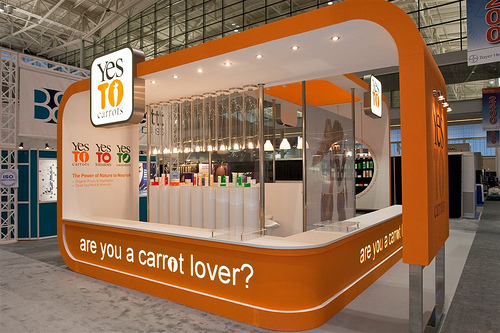
Ido: What do we mean by different? We mean be bloody different. A few months after we shook hands with Walgreens on our online exclusive, I went to an industry conference in Hong Kong called the Cosmoprof convention. I’d squeezed Lance for about 200 percent more money than he thought we could afford; it was still a minuscule budget by the standards of a big trade show. We’d found an architect in Israel who designed a fantastic, modern, über-hip booth for us and the aforementioned builders in Hungary who were willing to build it for a fourth of the cost of Israeli contractors. Nobody knew anything about us except that we were the brand new company with the over-the-top, bright orange, sexy booth. The booth had a carrot structure that rose like an orange Taj Mahal over the rest of the exhibitors. The green fronds brushed the ceiling and could be seen from any point on the floor. We filled it with energetic young people, glowing with good health, who handed moisturizer samples and carrot juice to everyone who walked by. Basically, we were the party booth, and we were packed from morning to night. Turns out that our structure was ten feet too high and broke every rule of the convention center, but we managed to stall the demolition team till the last day. By the time the convention wrapped, we’d drunk our own weight in carrot juice many times over, but we’d also made hundreds of new friends and new contacts. Success. Now when we attend conferences we do it with an even more fantastic booth than we had at the last event. Other companies recycle their booths for decades. What’s fun about that! Sometimes the booth will have a Frank Lloyd Wright look to it, other times it will be futuristic, but it is always big, orange, and fun. No matter what, our booth changes every year and is always the one that people are talking about on the opening day of the convention. A first impression is always going to be the most lasting impression. There is a certain expectation that your booth and your presentation will reflect the reality of your business’s size and market share.
This is an expectation that we chose to ignore. Our booth reflected the company we planned to be in a few years, not the company we were at that moment. So you don’t need the biggest booth or the biggest budget. But at the same time, you can’t simply follow the norm of having a plasma screen playing a generic video or hosting a random giveaway or competition.
By the end of a trade show, people want two things:
• They want to be entertained.
• They want free stuff.

If you can make them laugh and send them home with a bag of goodies, then you have a reasonable chance of getting them to remember you. Think of a trade show as speed dating on a massive level. Every account in that convention hall has the opportunity to sit down with every buyer for three minutes. In those 180 seconds you need to find some way to click with them, make them laugh, give them an insight into your brand’s philosophy, put some samples in their hands, offer them a carrot juice and a key ring, and hope and pray that they felt the same little spark that you did. It always shocks us when we see brands not putting a 150 percent effort into a trade show. I feel personally offended when I see attendees sitting down and reading the paper or sneaking out early. What’s the point? Attending a trade show is a massive investment, especially if you’re a small company with a modest budget. Don’t slack off even when you see your competitors half-assing it. In fact, look at their half-assing as an opportunity for you to wow the retailers they are underwhelming.
The Master’s Degree of Trade Shows: Working the Show
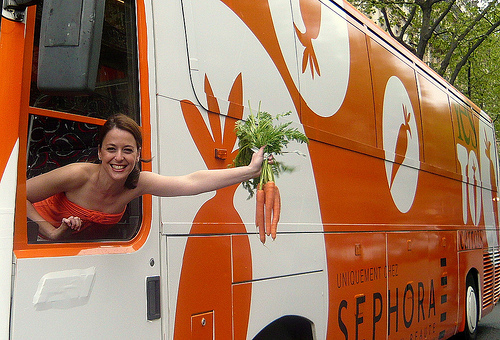
Lance: In our early days with Yes To we made a huge effort to attend the Cosmoprof convention in Italy. This was a biggie, and we put down a huge amount of cash to fly our team out, assemble gift bags, and make our booth look fantastic. By the end of day two, though, our booth was quiet; all the good-looking carrots, handing out juice, and the team couldn’t get people interested. For whatever reason our magic wasn’t clicking. “What the hell are we going to do?” I wondered. “This is a disaster.” “Why?” Ido asked.
“Because our booth is empty, and it’s been empty all day!” Ido laughed.“Mate, we built this booth to meet one person, from one account. I’ve met him, he loves us, and nothing else matters.”
Have goals. Be strategic. Know whom you need to meet and what kind of business you need to do with them. Identify your “whales,” the most important people you want to meet at a trade show. It’s critical that your team knows the names (and ideally the faces) of the whales on your hit list. Make sure they understand that if Mr. or Ms. Whale shows up, then they need to get your attention immediately. Trade shows are full of perfectly charming people who are lots of fun but essentially irrelevant to your business. If you are talking to one of these people, and you miss your chance to talk to the whale, then you are in trouble.
Ido: I’ve shamelessly run after a whale that got away; Captain Ahab would be proud of me! After all, this might be the only day your particular Moby Dick attends the trade show. Do not miss your opportunity to talk with them. Manifesto Rule Numero Uno: Turn the convention hall into a walking billboard about you and your brand. Conventioneers love tote bags. Why? Because there are tons and tons of free stuff to be had, and after about two hours they are going to need something to carry the swag in. We always order thousands of great tote bags. No cheap paper or thin cotton for us. Our bags are big, bright, and unique, and by day two we try to make sure that every single person in the hall is carrying one. Be shameless and be fun. Slap your logo on the bag, add some bright colors, and make sure that people instinctively smile when they see it. Have tons of product to give away at the booth, and give it away freely. Don’t be one of those guys withholding the good stuff for the “big guys.” Instead, be the guy with the product that everyone is using and talking about. Freely distributing swag (even if it costs you) is in your best interests; you want those walking adverts wandering the convention.

Try to stay in the hotel where the important people are staying, because you want to be able to interact with them in the elevator, in the bar, or at breakfast. A two-minute conversation in the breakfast buffet line can be invaluable if it creates a tiny bond or shared experience between you and an important buyer. Give yourself the chance to have that moment. These hotels are expensive, but it is so, so worth the extra cost if you are able to use it to your advantage. Always make sure you and your team have a uniform — and not a suit. Order some logo shirts, but make sure they are funny, not droney. Do something goofy and unexpected. Order everyone in the team those East Coast preppie trousers that are covered with embroidered whales. Have fun with it, but whatever you come up with, make sure it makes you stand out. You want to be a little bit different and also be comfortable, so don’t wear a corporate, uninviting suit. One caveat: It’s useful to have someone who looks more conventional in your booth. Some of your meetings will be with a person who needs the reassurance of seeing someone who looks a little square. Lance: At every damn trade show Ido sees me putting on my jeans and polo shirt and says, “I’m dressing cool, you dress like the accountant.”
Ido: That’s just because of your terrible taste in jeans. No, we need one guy who looks serious and traditional, and seriousness comes more naturally to Lance. Note: The more conventional, reserved-looking guy should not be the boss or, in our case, both of the bosses. Make sure that at least one of the founders or the CEO is wearing the more casual look, like everyone else. You want your CEO or founder to be fun and superapproachable. You don’t want him or her wearing a suit and sitting in one spot and looking like a monarch on a throne. Keep the boss approachable, and don’t create the impression that you have an impenetrable hierarchy. Buyers buy from people they know, like, and trust. Give them a chance to build that relationship with the head guy, even if it is the one and only time they will ever have anything to do with him. Always have a pen and paper, or an iPad, or a voice recorder handy. As soon as you finish a meeting, scribble down all the pertinent information: name, contact info, and any details you can recall. Small talk is everything, and six months later you may be glad you remembered that their youngest is playing ball at State, or that they grew up in an area you know well. Send a follow-up note to everyone you contacted over the course of the day, and every evening debrief with your team so you figure out who to delegate your new contact to. Keep the initial note brief; no one has the time or energy to read a detailed letter while the show is still running.
Once you are back home, give them a couple of days to settle back and then hit them again with an action-based e-mail. Always remind them who you are, and refer back to your notes. If you have a personal comment that feels appropriate, such as, “I hope John’s first day of school went well,” make it. Know how to cut your losses; if someone says, “I am coming back,” without scheduling an actual time to return and talk, it means they are never coming back, ever. Let it go. The minute the trade show closes for the day is the minute the real work begins.
Practice the fine art of thinking while drinking

Lots of the important business at a trade show is done after the convention closes for the day. In order to get in on these opportunities, you need to be organized, aggressive, and targeted. Plan ahead. You want at least one after-hours social interaction with all your potential partners, retailers, distributors, press, and even your competitors. You need to start planning these social interactions months before the convention, so start calling and e-mailing and Facebooking well in advance of the show. Don’t be afraid to approach people whom you’ve never met or who feel “out of your league.” Everyone is in the same boat of wanting to connect with people and discover the next big idea before their competitors do. This makes it relatively easy to get a meeting at a convention that you might struggle to get in day-to-day life.
You are at that convention to build relationships and make friends, and the after-hours booze fest known as “cocktail hour” is a great place to do so. For better or worse, conventions are fueled by alcohol; this can be challenging if you don’t drink, but either way, it’s critical to be out there taking part. Conventions, especially the after-parties, can also be tricky if you’re not a naturally outgoing person. I have friends and coworkers who are great in the more structured environment of the convention floor but struggle with the after-hours socializing. It’s critical that you are genuine, relaxed, and unguarded, so find something about the evening that you enjoy. Go to karaoke. Laugh. Have fun. Say yes to after-dinner drinks and late-night drinks; late-night drinks is where you can form the strongest relationships. People are relaxed, they open up a bit, and you will have a really memorable shared experience to refer back to as your relationship develops.
Lance: Ido and I never sit together at these after-hours events. We spend plenty of time together as it is! You should chat and catch up with your partner only when you go back to your room to debrief. These after-dinner and late-night drinks are work, and we stick to our divide-and-conquer strategy. If I had a huge ego, this would be a problem, but the reality is that there is room for only one star, and in this setting the star is Ido. In this business you have to put away your feelings of insecurity. You don’t need to show them, particularly when you are trying to sell an aspirational brand. So I’m cool with Ido having the spotlight, and I use my time most effectively in supporting him as he makes these connections with the major players. At the end of the day, we both end up winning.
Be the most noticeable guy in the room
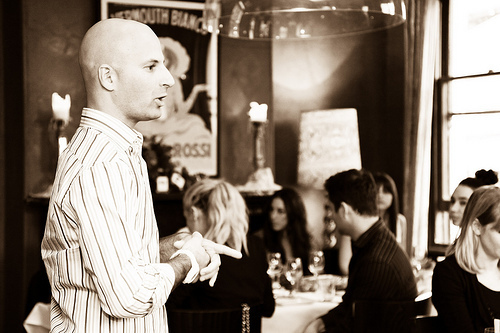
If you have a key account coming to a trade show, do whatever it takes to have him or her to yourself for the night. Don’t book the best restaurant in town. Book the most fun restaurant in town. The dinner is not about spreadsheets and marketing plans; it’s about eating great food, drinking plenty of great wine (or, in the case of some of our most “fun” accounts, getting blasted on shots of Jägermeister), and truly becoming friends with people whom you generally do not get to see outside of a corporate setting. There are going to be a few meetings that are a tougher “get,” and these are generally the very biggest companies at the show. If you’re struggling to get a meeting with them, ask around and find out if they are throwing a party. Yes? Great! Go and have fun and shake some hands. This is an infallible strategy — if you’re invited! If you aren’t invited, then you need to worm your way onto the guest list. The more exclusive the party, the more important it is to attend. So here’s our crash course in, well, crashing.
1. Ask your neighbors and customers what they are doing that evening; identify the big-ticket party for that night. Are you on the list? No? Then get working!
2. Find the best-looking and most genuinely charming guy or girl from your booth. Brief them on their objective and send them off to infiltrate the booth of the company hosting the party. Arm them with free samples and big smiles.
3. If that doesn’t work, find out where the party is, dress up, and tag along with a few other people that you know were invited and behave as though you own the joint (works 95 percent of the time). Effusively shake the host’s hand and thank him or her for the invite. Now that you’ve been such a mensch (gentleman) there’s no way they can kick you out!
4. Party like they are throwing the event just for you! Don’t act like a fool, but make sure everyone at the event knows that you are the life of the party.
5. Convince your most important suppliers/friends/staff to join you for after-party drinks at the bar in their hotel.
6. Look at your watch and realize that the conference floor opens in forty-five minutes! Run up to your room. Do fifty push-ups and drink three coffees.
7. Repeat every night till you are ready to cry with exhaustion.
8. Go home!
Treat your booth with love, and it will love you back.
First, make sure you have lots of products to swap at the end of the show! Your spouse/partner/roommate will be very happy because you can barter your stuff for other people’s stuff. Second, all conventioneers love getting products for free or in a barter. They’ll give it to their friends, or even better, give it to their family members, and there is nothing more effective than a buyer’s family liking the product. Most trade shows end in the early afternoon of the last day, and most trade show rules stipulate that all attendees keep their booths fully open till the very last minute of the last day of the trade show. But that last day is hard; you’re exhausted, and all you want to do is go home and sleep. You suddenly realize that consuming nothing but coffee and pretzels for four days is a questionable idea. By noon the convention floor is almost empty, with only a few people running around to wrap up last-minute deals. The temptation to put up your “closed” sign and slip some teamsters $500 to make your booth go away is HUGE.
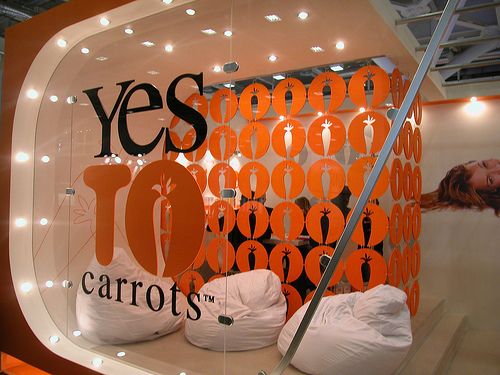
Don’t do it. As much as you may be sick of the sight of your booth by the end of an event, always treat it with respect. Remember that you are going to want to use parts of it again, so don’t just hand over the job of tearing it down to a couple of guys loitering around the coffee stand. Always make sure you know who is going to pull the booth down and where it is going to go. Make sure your original builder has supplied some kind of plan for safely packing and shipping the booth. We ended up flying two men over from Hungary to pull down our first booth; we reckoned that the additional investment was worth it if it improved our odds of still having a beautiful booth for the next trade show.
Third, and equally important, squeeze every drop of value out of that show. The last day is generally quieter and slower and you never really know who might show up at the booth. If the last day is very quiet, it can be a good time to start following up on the people you and your team met during the show. Make sure you speak to the show organizers to secure you the same or a better location for your booth for next year. (If you forget to do this, you may end up wedged in between the line for the toilets and the rubbishy food outlets. Not good.)
The Multibooth Philosophy

After a show, our booth is shipped back to a storage facility, which is a little like the government warehouse in Raiders of the Lost Ark. We have various booths in storage crated up and ready to go. Our philosophy is to never show the same booth twice at the same convention or trade show. For example, the Taj Mahal Carrot will never go back to Hong Kong, but it will do very well at Las Vegas. The goal is to keep things surprising and fresh. You want people to be curious about what you’ve done differently from last time, and by rotating the booths we maximize the chances of our important accounts seeing something new every year. You may not have the budget for this; if that’s the case, then get creative. Keep the same basic shell, the same colors and overall design philosophy, but change things up a little. Have fun, but make sure your aesthetics align over the years. You want to surprise people, not confuse them.
Getting people excited about Yes To was the easy part. The hard part was everything else! Even while we were circling the world on the Trade Show Express, we had to deal with the nuts and bolts of actually manufacturing and shipping ever-increasing amounts of product. Now, remember how we talked about how partners have to work well together, in good times and bad? Another one of those bad times is coming up right now.
Additional Resources
Trade Show Directories and Tips
2012 Top 250 US Trade Shows
Trade Shows, Exhibitions, Conferences & Business Events Worldwide
Exhibitor Magazine’s Exhibit Design Awards
Exhibitor Magazine’s Sizzle Awards
22 Tips on How to Operate a Trade Show Booth
Exhibitor Central – Tradeshow Tips
Barzilai Design (our exhibit design firm)
Tools
Evernote (for note taking)
BuildASign (for signs and print)
Chimpadeedoo (for capturing leads)
Square (for collecting payment)
Cafepress (for schwag)
InternMatch (for finding booth staff)
For the detailed story of Yes To’s improbable rise, including the stupid mistakes, near fatal catastrophes, existential crises, and fancy sales footwork, check out Get Big Fast and Do More Good: Start Your Business, Make It Huge, and Change the World.






November 3, 2013
“Productivity” Tricks for the Neurotic, Manic-Depressive, and Crazy (Like Me)

Sometimes, life seems upside-down.
I originally wrote this post months ago, but I’ve been too self-conscious to publish it until now. This quote convinced me to put on my big girl pants:
“The moment that you feel that, just possibly, you’re walking down the street naked, exposing too much of your heart and your mind and what exists on the inside, showing too much of yourself. That’s the moment you may be starting to get it right.”
- Neil Gaiman
University of the Arts Commencement Speech
So, here goes, and I hope it helps at least a few of you.
Reality Check
A few months ago, I had a birthday party.
A dozen friends and I gathered for several days of wonderful sun, beach, and catching up. On the last day, I didn’t get up until 11:30am, knowing full well that the last remaining friends were leaving at 12 noon.
I was afraid of being alone.
Like a child, I hid my head under the covers (literally) and hit snooze until reality couldn’t be postponed any further.
But…why am I telling you this?…
The Dangerous Myths of “Successful” People
We all like to appear “successful” (a nebulous term at best) and the media like to portray standouts as superheroes.
Sometimes, these dramatic stories of overcoming the odds are inspiring. More often, they lead to an unhealthy knee-jerk conclusion:
“Well… maybe they [entrepreneur/artist/creator painted as superhero] can do it, but I’m just a normal guy/girl…”
This post is intended to give a behind-the-scenes look at my own life. Though I’ve occasionally done profiles like A Day In The Life with Morgan Spurlock’s crew, I rarely let journalists follow me for a “normal” day. Why?
I’m no superhero. I’m not even a consistent “normal.”
In the last 3 months, I’ve:
Cried while watching Rudy.
Repeatedly hit Snooze for 1-3 HOURS past my planned wake time, because I simply didn’t want to face the day.
Considered giving everything away and moving to Montreal, Seville, or Iceland. Location varies based on what I’m escaping.
Seen a therapist for the first time, as I was convinced that I was doomed to life-long pessimism.
Used gentlemanly (ahem) websites to “relax” during the day when I clearly have urgent and important shit to do.1
Taken my daily caffeine intake (read: self-medication) so high that my “resting” pulse was 120+ beats per minute. 8-10 cups of coffee per day minimum.
Worn the same pair of jeans for a week straight just to have a much-needed constant during weeks of chaos.
Seems pretty dysfunctional, right?
But, in the last 8 weeks, I’ve also:
Increased my passive income 20%+.
Bought my dream house.
Meditated twice per day for 20 minutes per session, without fail. This marks the first time I’ve been able to meditate consistently.
I’ve cut my caffeine intake to next-to-nothing (in the last 4 weeks): usually pu-erh tea in the morning and green tea in the afternoon. I’ve had no more than 1 cup of coffee per week. More on this in a later post.
With your help, raised $100,000+ for charity:water for my birthday. (Thanks to John Park for bringing the thunder!)
Raised $250,000 in 53 minutes for a start-up called Shyp.
Signed one of the most exciting business deals of my last 10 years.
Added roughy 20 pounds of muscle after learning the pain and joy of high-rep front squats (and topical DHEA, courtesy of Patrick Arnold).
Transformed my blood work.
Realized — once again — that manic-depressive symptoms are just part of entrepreneurship.
Come to feel closer to all my immediate family members.
The Point
Most “superheroes” are nothing of the sort. They’re weird, neurotic creatures who do big things DESPITE lots of self-defeating habits and self-talk.
Personally, I suck at efficiency (doing things quickly). Here’s my coping mechanism and 8-step process for maximizing efficacy (doing the right things):
1) Wake up at least 1 hour before you have to be at a computer screen. E-mail is the mind killer.
2) Make a cup of tea (I like pu-erh) and sit down with a pen/pencil and paper.
3) Write down the 3-5 things — and no more — that are making you most anxious or uncomfortable. They’re often things that have been punted from one day’s to-do list to the next, to the next, to the next, and so on. Most important usually = most uncomfortable, with some chance of rejection or conflict.
4) For each item, ask yourself:
- “If this were the only thing I accomplished today, would I be satisfied with my day?”
- “Will moving this forward make all the other to-do’s unimportant or easier to knock off later?”
5) Look only at the items you’ve answered “yes” to for at least one of these questions.
6) Block out at 2-3 hours to focus on ONE of them for today. Let the rest of the urgent but less important stuff slide. It will still be there tomorrow.
7) TO BE CLEAR: Block out at 2-3 HOURS to focus on ONE of them for today. This is ONE BLOCK OF TIME. Cobbling together 10 minutes here and there to add up to 120 minutes does not work.
8) If you get distracted or start procrastinating, don’t freak out and downward spiral; just gently come back to your ONE to-do.
Congratulations! That’s it.
This is the only way I can create big outcomes despite my never-ending impulse to procrastinate, nap, and otherwise fritter away my days with bullshit. If I have 10 important things to do in a day, it’s 100% certain nothing important will get done that day. On the other hand, I can usually handle 1 must-do item and block out my lesser behaviors for 2-3 hours a day.
It doesn’t take much to seem superhuman and appear “successful” to nearly everyone around you. In fact, you just need one rule: What you do is more important than how you do everything else, and doing something well does not make it important.
If you consistently feel the counterproductive need for volume and doing lots of stuff, put these on a Post-it note:
Being busy is a form of laziness–lazy thinking and indiscriminate action.
Being busy is most often used as a guise for avoiding the few critically important but uncomfortable actions.
And when — despite your best efforts — you feel like you’re losing at the game of life, remember: Even the best of the best feel this way sometimes. When I’m in the pit of despair, I recall what iconic writer Kurt Vonnegut said about his process: “When I write, I feel like an armless, legless man with a crayon in his mouth.”
Don’t overestimate the world and underestimate yourself. You are better than you think.
And you are not alone.
And If You Struggle…
If you occasionally struggle like me, these resources and articles might help you rebound:
The Prescription for Self-Doubt (Video)
Harnessing Entrepreneurial Manic-Depression: Making the Rollercoaster Work for You
Two Root Causes of My Recent Depression (by Brad Feld, one of my favorite start-up investors)
Did you find this post helpful? Please let me know, and if you have any particular strategies or quotes that help get you out of funks, please share in the comments!
Any guy who insists he’s never done this should not be trusted.






October 30, 2013
The Tim Ferriss Experiment (TFX) TV Trailer
Just a taste of things to come!
For more info on the show, see this post.
The uber-short version:
The Tim Ferriss Experiment (TFX) premieres December 1st at 8pm EST on Upwave on HLN (Formerly CNN Headline News). Here’s Turner’s show site.






October 28, 2013
How to Create a $4,000 Per Month Muse in 5 Days (Plus: How to Get Me As Your Mentor)

Photo: Stuck in Customs
Preface by Tim
This post is a follow-up to “How to Create a Million-Dollar Business This Weekend (Examples: AppSumo, Mint, Chihuahuas).”
The purpose of this guest post — written by Noah Kagan — is to show you exactly how a postal worker created a $4,000 per month muse. Included are all the tests, e-mail templates, and details you’d need to replicate his success.
Noah was employee #30 at Facebook, #4 at Mint, had previously worked for Intel (where he frequently took naps under his desk), and had turned down a six-figure offer from Yahoo. Since we first met, Noah’s helped create several multi-million dollar businesses, including AppSumo, loved by entrepreneurs everywhere.
For those interested in mentorship, don’t miss the end of this post.
There’s a time-sensitive chance to visit San Francisco for a week… to be mentored in-person by Noah and yours truly.
Enter Noah
The journey of Daniel Bliss is a telling one.
Our goal was to take his hobby — he was a full-time postal worker — and turn it into a real business making $4,000 a month so he could quit his day job.
We started working a few months before when he won the AppSumo Make a $1,000 a Month Business getaway to Austin to personally work with me for a week.
The preliminary call after Daniel won the getaway went well. Here’s what he told me:
He was solving his own problem. This is an easy way to figure out what business you should start.
Daniel’s a rock-climber and it hurt his neck to look up while he was belaying (standing on the ground helping the climber above him) so he wanted to buy glasses to make his neck hurt less.
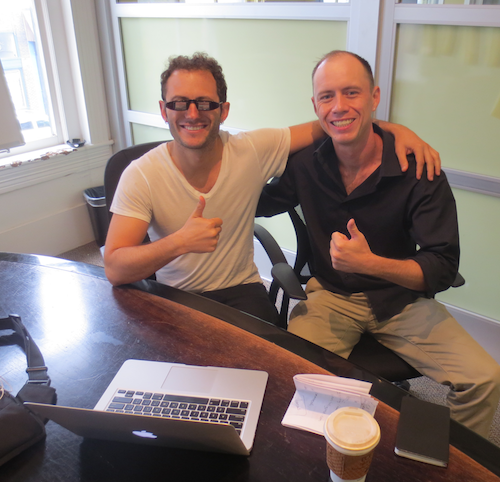
Here’s me with a pair of glasses on and Daniel.
All the glasses on the market were $99, so Daniel figured there had to be a way to make and sell cheaper glasses.
When we talked, he had already found a manufacturer through Alibaba.
Daniel first learned about using Alibaba to find a manufacturer in Tim Ferriss’s book The 4-Hour Workweek (page 175).
He searched suppliers on Alibaba and checked if they were a good fit by testing them on 3 characteristics:
1. How many years (if any) have they been considered a gold supplier?
Gold Supplier is a paid membership on Alibaba.com. All Gold Suppliers in China must pass an onsite check while those from other countries and regions must pass an A&V Check. Basically, this shows that they’re legit.
2. How is their website?
Poke around to see if anything seems shady. Do they have any negative reviews or positive ones? Search their name/email on Google and see what kind of results you get. This should give you a good feeling if they’re legit or not.
3. Is their “minimum order quantity” reasonable for what I’m trying to do?
You want to keep your costs down and not worry about selling hundreds of items. Daniel originally targeted 50 minimum pieces to validate his business without spending a lot of money.
Once Daniel narrowed down suppliers he ordered a few samples to test in person. He took these to his climbing group. Always look at who you have easy access to when selling your product. A common pitfall is for people to look at everyone outside their network and get rejected.
By himself, he sold 12 pairs. He sold 2 pairs to a couple he met while climbing and the rest to his climbing group.
So far, so good.
But then Daniel decided to spend valuable time creating a website: http://belayshades.com
How often have you bought a domain, imagining how large your new business is going to be? I KNOW you have. I have many times. You fantasize about how large your business is going to be instead of actually growing it. This is a common thing we help people with in our Make a $1,000 a Month business course.
Daniel’s been working as a postal carrier in Canada for 7 years, so expanding a business was foreign to him.
Daniel had gotten to the point where he was working without a goal so the first question I asked him was:
“To you, how much money is financial freedom?”
Once you know your destination, getting there is MUCH easier.
Tim’s written about figuring out your lifestyle costing, aka “financial freedom,” here: http://www.fourhourworkweek.com/blog/lifestyle-costing/
For Daniel it was $4k / month to be able to travel to Thailand and go climbing as he pleased.
Now it’s key to do the math to see how many pairs of glasses he’ll need to sell to get to that point.
$4,000 / profit a month
The glasses sell for $60 a pair with shipping
40% profit margins on every pair of glasses.
$60 * 40% = $24
$4000 / $24 (profit per sell) = 166 glasses a month.
Basically, 5-6 glasses a day.
That doesn’t sound so bad, right? When you take a goal and break it into daily targets, it makes the goal seem WAY easier and more digestible.
Competitors?
Before Daniel arrived to work with me, he started worrying about competition and patents.
BUT NO COMPETITOR CARES. Ever!
How many burger places are in your town? Cafes? Japanese restaurants?
Exactly, A TON. There’s enough for everyone and — fortunately for you — most people run their businesses like shit.
Worrying about others in the beginning is just a fear of starting.
Daniel’s focus on filing a patent was another aversion to starting.
The next week, he was worried about liability and everything except growing his business.
I’m not saying you should avoid setting up your corporation or take precautionary measures when it’s the right time. The key is to see what’s actually important for the time being and handling it.
Eventually, Daniel arrived in Austin and we had 5 days together to get his business to at least $4,000 in revenue. Here’s what went down:
Day 1 – Foundation
Now that Daniel knew his goal (sell 5-6 glasses a day) we used Quant Based Marketing to calculate how he could try various marketing tactics to grow his business and reach his goal.
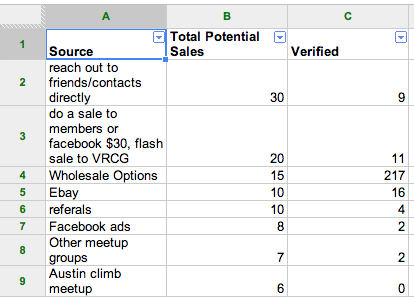
Example of Daniel’s Quant based sheet
See the actual marketing sheet here and feel free to use it for your own business.
What Daniel was previously doing for marketing was paying for Facebook likes and cold calling rock-climbing gyms to gain sales. It was going slowly.
The gyms said they needed time to see if they wanted to buy the glasses. When someone says they need time, it’s because you haven’t sold them properly.
For marketing, the key is to have a “lazy” mindset. With the quant sheet you can estimate the amount of sales you can get from all the different activities and then prioritize based on volume.
It’s critical to find the marketing activities that can scale and be repeated.
Daniel kept doing activities that weren’t producing, like submitting to PR Newswire. It’s not that it can’t work, but we wanted to get results faster.
So I asked Daniel, “If you could only use two of the marketing activities you’ve used before, what would they be?”
1. Personal network + referrals
2. Wholesale selling to climbing gyms / online stores
So we had our marketing sheet and planned to do 1-2 activities per day to see what worked best for his business.
Day 2 – Doing more of what works (personal network + wholesales)
Daniel searched Facebook for every single friend who listed climbing in their profiles and added them to a sheet.
Then Daniel individually messaged them. Yes, it’s work. To get The 4-Hour Workweek I’ve found it takes about 6 months of work to finally relax on substantial monthly income. [Note from Tim: This squares with reality; it usually takes 3-4 months to try enough that you can do a proper 80/20 analysis, then two months to design systems to scale what *is* working.]
Here’s the message Daniel used:
Hey
Hope you’ve been awesome.
I saw you like climbing. Me, too!
My neck always hurts when I belay, so I created super affordable belay goggles.
Have about 10 available. Are you interested?
Climb on,
Daniel
A few sales came just from messaging his Facebook friends. SCORE.
Then we created a list of every rock climbing store offline and online in Canada.
1. Search google for “rock climbing vancouver” or search “rock climbing” on Yelp
2A. Go to websites listed and get the owner’s name (if possible), email, and phone number. OR
2B. Hire someone on fiverr.com or craigslist to go through every listing and add them on a sheet for you like the one below (if you’re a lazy ass).

Daniel was already calling and emailing but not getting the volume of sales he needed from wholesalers and gyms. I asked to see what he emailed,. He showed me this:
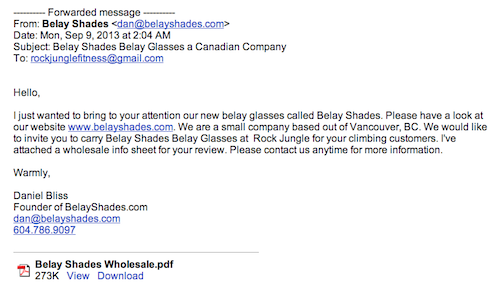
Damn, that is a bad e-mail!
Main things for you and Daniel to learn:
a) Getting a PDF from a random stranger is never something I want to open.
b) Make the subject line exciting to read.
c) Sales emails should ALWAYS be about the other person. Make it valuable for them so they want to reply.
d) Nobody’s name is Hello. “Hey ”. Work to find the first name.
Here’s an improved version that we worked on:
Subject: Helping you make an extra $1,000 at your climbing gym
Hey Colleen,
Hope things are amazing with you.
I’ve been working with climbing gyms like yours and wanted to hook up your members with my new belay glasses.
http://belayshades.com (people go nuts over them)
Was thinking, we can email your members with a special discount just for you and we split the profit evenly.
Be a great way for you to make a profit and hook up your members at the same time.
Can you let me know by this Friday if this sounds appealing to you?
Rock on,
Dan Bliss
And here’s the email for online retail stores:
Subject line: Best person to talk with for new climbing gear?
Hey John ,
Fan of your store and the fact your founder and I both do jewelry making

Noticed you didn’t have any belay glasses, which are becoming super popular with climbers.
Love to see if this makes sense for your store. Other climbing stores are seeing promising results with it.
How’s this Thursday 4pm CST for a quick 7-minute call to see if this makes sense for your store?
Belay on,
Daniel Bliss
To actually get a response, I had Daniel use what I call the quad-bomb:
1. Search their name on LinkedIn. Send them a connect request as a friend with a CUSTOM message. “Hey , Huge fan of your business and wanted to talk about some cool products for your customers.”
2. Email them.
I wait a day here as to NOT annoy them. If they don’t respond, then proceed to 3 and 4.
3. Facebook message them with: “Hey, just wanted to make sure my message got through”.
4. Tweet them. “Hey @twitter-handle. Love to see if we make some magic together. What’s best email for you?”
Why so many channels?
1. So many people are lazy and don’t put the effort in. You get out what you put in.
2. Sometimes people get busy, so your email may just get buried at the bottom of their inbox.
One of the key things that I drilled into Daniel’s head is to have a follow-up time with ANY person you are trying to work with. I use the line, “I have my calendar open, how’s X time to check in?”
Also I use followup.cc as a great free service to get reminders via email.
Rebuttal / sales sheets
Script out your answers to any possible questions during sales calls. This makes it easy to do your sales. This is also valuable so in the future you can have ANYONE do your sales a la The 4-Hour Workweek.
Here’s a sample of those sheets:
Rebuttals:
You guys are too small for us to work with
I feel we will work well together… we are small and you are big. Since we are small we can keep costs low and pass the savings on to you and your customers. Since you are large and have the reach for distributorship we can do business on a larger scale at smaller margins while still making a profit. Match made in heaven.
What about returns or defects?
We check each product by hand. If there is any problem, we stand 100% behind the product. We have a no-questions return policy for 30 days.
Can you guys do net-90 payment terms?
Yes, we can.
Where have you sold these glasses so far?
We are selling at local gyms and climbing groups all around Vancouver.
Can you give us a discount?
The price is the most affordable on the market. If you wanted to place a larger order, or can offer better payment terms, I’m happy to talk to my team to make it work for you.
Sales Questions to ask whosalers / stores / gyms
1. Something about themselves, a get-to-the-know-them question
2. What are your most popular items for climbers?
3. What are your favorite sites for finding out about new products? If tradeshows, which ones do you guys go to?
4. Do you guys already sell belay glasses?
5. How do you decide which products you want to sell?
6. [POTENTIAL TRANSITION] Well, it sounds like our glasses are right up your alley… (ONLY IF THEY ARE)
7. What’s your preferred amount for a starter order?
8. Is anything holding you back from placing an order of 30 with us today?
9. What are your preferred next steps to get this partnership rolling?
10. How’s x time for a check-in to make sure all is smooth?
Day 3 – Marketplaces + Groups + Advertising
Each day Daniel was in town, he allocated at least 3 hours to try a new method of marketing.
Who knows which will actually work? At the end of the week, we were going to re-evaluate and focus on the most effective ones.
Here are 3 marketing methods we tried out:
Posting on marketplaces
This involves posting your product to sites that already have your customers like eBay, Etsy, Craigslist or Amazon. All totally free, too. Done.
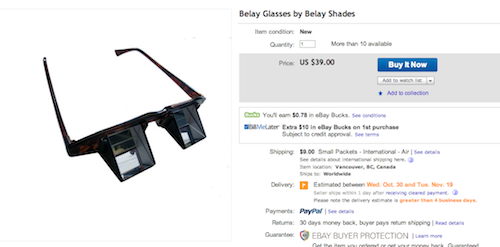
http://cgi.ebay.com/ws/eBayISAPI.dll?ViewItem&item=321233764523
Messaging on Meetup groups
Try messaging meetup groups to do giveaways. No responses? Oh well, move on.
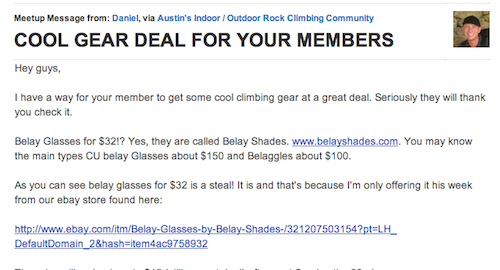
Facebook and Google Advertising
Here’s the exact FB ad we created:
Key things about this ad:
– Target audience is really small (24,000 people)
– Your target should be as NICHE as possible. The more unique — or direct the competitor — the better.
- Newsfeed ads have been performing STUPIDLY well for me, so we chose that route. But what works for me may not work for someone else.
- Limit yourself to your country and focus on just desktop computers, unless your page is very mobile friendly. Otherwise, you will waste a TON of money.
For Facebook ads, do NOT spend more than $10 a day while you are trying to figure out if you can make more than you spend from this marketing channel. DO NOT buy likes either — they are worthless. You have to rely on Facebook to communicate with your customers vs. having direct access. Get people to buy your product directly or give you an email.
Daniel tried Google Adwords with no success. Luckily, he used a free credit he got from starting a new account. You can get bonus AdWords credit via eBay.
Day 4 – Giveaways / Google / Random ideas
On Day 4, we continued trying new marketing techniques to find which would work:
Giveaways
Daniel reached out to various Facebook pages and bloggers related to climbing. Search Facebook for “rock climbing” or whatever your product is, and you should be able to find a few pages related to your audience.
Here’s what he would message them:
Subject: Free Belay Glasses for you and your
Hey ,
You guys look awesome! Glad to see the climbing community growing in .
Wanted to let you know about these cool new belay glasses for rock climbers http://www.belayshades.com
Love to send you a pair to try out. If you like them, I’ll happily give you guys a special price you can share with your members.
Easy enough, right? Just email me by with an address we can ship to, and we will send a pair out to you.
Belay on!
Daniel
This did not produce any results 
A better approach would be to mail out glasses to climbing writers and group owners and focus on building long-term relationships.
Google Top 20
If you were your own customer, what phrase would you search on Google?
For Daniel it was “belay glasses”.

In a non-spammy way, go through the first 2 pages of results on Google and leave a helpful comment or see if you can sponsor or get involved in that page. Way easier than trying to immediately rank for a keyword through SEO.
Daniel found a lot of forums and blog posts so he promoted himself on these pages. By looking at Google Analytics, we saw this drove a decent amount of traffic and sales to his website.
Posting on Reddit
There’s a decent amount of people in the /r/hiking or /r/climbing subreddits so posting a discount or asking for people’s feedback is a good test.
Daniel’s partner posted this thread and was able to sell a few glasses:

This sold 10 pairs, which is awesome for Daniel! But posting on Reddit and hoping to get responses isn’t predictable, and we want predictable. Can’t run off to Thailand unless you know cash is coming in consistently, right?
Updating his website
His site wasn’t bad, but he had a video that did not explain his product, as well as a random banner slide show that didn’t speak to visitors.
Before:
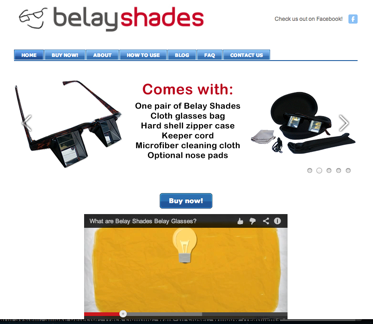
After:
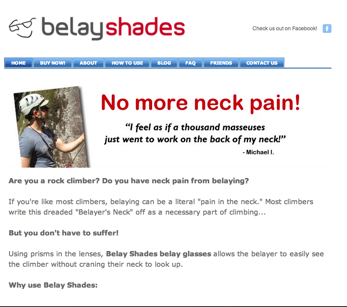
Day 5 – Bringing it all together
The key takeaway from the whole week: looking at what drove most sales so we can scale it up big time.
So from all the days activities, Day 2 seemed to be the most effective (reaching out to personal network and wholesale retailers).
Our goal for the five days was to grow Daniel’s business. By reaching out to his personal network and wholesale retailers and focusing what had already worked, we managed to make that happen.
Daniel got an email from a large online site named Sierra Trading saying they were interested in the glasses.
HOLY CRAP! He’d been waiting weeks to hear back from small local stores. Now an online provider is finally responding within a day. The store buyer originally responded via a Facebook message.
The order placed was for $4,200!!!!!
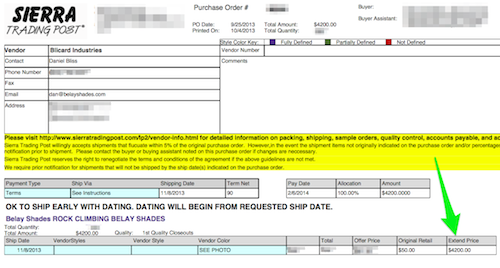
WAIT WHUH?!?!?!?!!!!
Lesson of the week: You never know what’s going to work when it comes to marketing. Try new things and then focus on what works until it stops working.
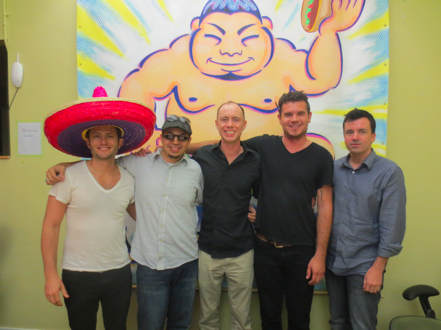
Daniel and the Amigos. Thanks to Anton + Robert for helping with this article.
Big thanks to HomeAway for sponsoring Daniel’s great loft in Austin, Texas.
A Week of Mentorship in San Francisco — An Opportunity
If you want help starting your own business, and if you’re a US resident age 18 or older, Tim and I have a special opportunity for you.
Take the following steps no later than 5pm PST on Wednesday, October 30th, 2013, and you could get an all-expenses-paid trip to San Francisco to work with us on starting your business.
Many surprises await the one lucky winner. Big time. Seriously.
Step 1 – Create a video (2 min or less) on YouTube explaining why you should be chosen. Start the video title with “Tim Mentorship” so we can find it.
Step 2 – Fill out this form. Be sure to include a link to your YouTube video (from Step 1) in the “Tacos or burritos?” answer! This is to ensure you know how to follow directions.
That’s it!

If you’re like Daniel and want the blueprint to start your own business, personal support, and access to a community of 3,000+ entrepreneurs, take a look at “How To Make A $1,000-A-Month Business.”






October 21, 2013
You Are What You Read: 14 Thought Leaders Share Their Bookshelves

Photo: Ozyman
The following is a guest post by Shane Snow, a frequent contributor to Wired and Fast Company. It includes photographs of some fun bookshelves, including yours truly (Tim Ferriss). CLICK ALL IMAGES TO ENLARGE.
Enter Shane
They say a person’s eyes are “the window to the soul.”
I am not very good at pupil-based soul-reading, but I’ve found that I can learn a lot about a person by the books on his or her shelf. When I go to someone’s house or office for the first time, my favorite thing to do is check out the bookshelf.
Here’s what’s on mine:
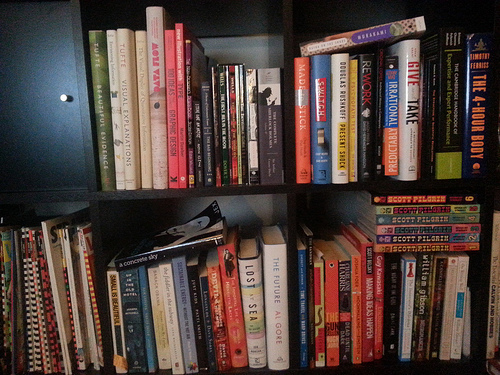
(click to enlarge any and all photos in this post)
Storytelling is a powerful force, as I’m a fan of reminding people. Stories—fiction and non—make ideas stick; they change minds and shape us in often subconscious ways. I believe the mind of a well-read person is heavily influenced by the books of her past.
A few weeks ago, I decided to conduct a little experiment.
I emailed a few friends and people I admired and asked them if I could see photographs of their bookshelves (or book stacks or Kindle screens). Just about everybody said, “yes.” The experiment soon metastasized, and I started pestering thought leaders in spaces I followed–tech, advertising, philanthropy–to see what books the innovators cared enough about to allot real estate.
Soon, I had more photos than I knew what to do with. Here are some of my favorites:
Hilary Mason, Chief Scientist at bit.ly and one of the smartest women in American tech
Fred Wilson, Partner at Union Square Ventures and the man responsible for investments in Tumblr, Etsy, CodeAcademy, KickStarter, Meetup, Soundcloud, Twitter, Behance, and StackExchange…
But I actually found this closeup in his Flickr photostream, too: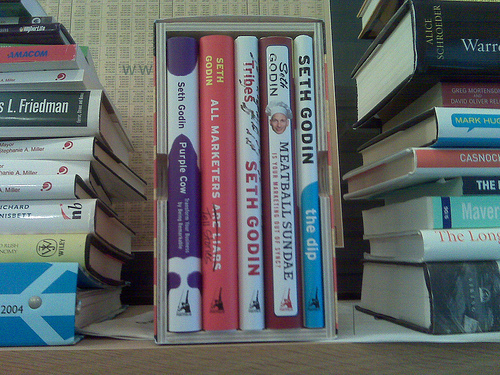
Guy Kawasaki, Bestselling Author of Enchantment, A.P.E., and a dozen other terrific books
Mike Lazerow, Founder of Buddy Media (sold to Salesforce last year for $700 million)
Mitch Kanner, Owner of 2Degrees and one of Ad Age’s “hottest rolodexes” in advertising (this guy hooks people like Jay-Z up with deals like Samsung’s million-album download)
Jonah Berger, Bestselling Author of Contagious and “virality” guru
Claire Ortiz-Diaz, head of Social Innovation at Twitter and one of Fast Company’s Most Creative People In Business
Dharmesh Shah, CTO of Hubspot and founder of OnStartups, and one of the most humble leaders you’ll ever meet
Dave Kerpen, Bestselling Author of Likeable Business and founder of Likeable Media (also the highest-trafficked LinkedIn Influencer in the world)
Cindy Gallop, renowned advertising executive and founder of IfWeRanTheWorld and MakeLoveNotPorn
Adam Grant, Bestselling Author of Give And Take and purveyor of revolutionary ideas about work and success
Clara Shih, CEO of Hearsay Social and board member of Starbucks (elected at age 29)
Jeffrey Walker, philanthropist and Chairman of JPMorgan Chase Foundation and author of the forthcoming book The Generosity Network
And I certainly couldn’t leave out Tim Ferriss, whose penchant for anime happens to be his secret weapon for language-mastery:
Interestingly enough, the book I referenced in the beginning about stories making ideas stick (Made To Stick by Chip and Dan Heath) shows up several times in this gallery. There are a few other repeats if you look carefully!
Of course, there were a number of well-read people whose bookshelves I’d love to get a peek at (but unfortunately couldn’t get a hold of). In particular, I wish I could check out the shelves belonging to the following five:
Arianna Huffington
Elon Musk
Martha Stewart
Joss Whedon
Cory Booker (and not just because of the name!)
We’re all a product to some degree of the books we read, the programs we watch, and the people we meet. In the comments, I’d love to discuss: What books from this gallery jumped out at you? Whose bookshelves above do you identify with in particular?
And, perhaps most importantly, what are the most important 2-3 books on your bookshelf?






October 13, 2013
Announcing: “The Tim Ferriss Experiment” on Primetime TV (And How to Join Me)
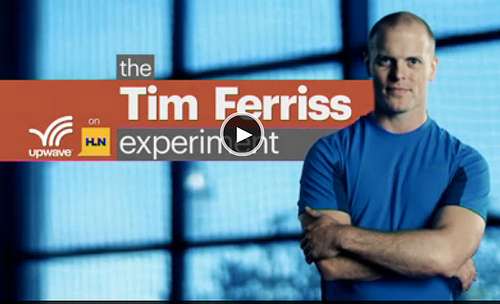
After ages of planning, I’m VERY excited to share big news with you all.
Starting this December 1st, I will have my own primetime TV show, airing Sundays at 8pm on HLN, formerly known as CNN Headline News. I’m both host and co-executive producer, and I’m currently filming my ass off. It’s all part of a big Turner Broadcasting initiative called Upwave.
Here are the basics:
Name of show: The Tim Ferriss Experiment (TFX)
The premise: Showing viewers how to become superhuman through better tools and tricks, not better genetics.
Easily thought of as: “Anthony Bourdain meets Jason Bourne” or “Jackass meets A Beautiful Mind”
Production company: Zero Point Zero (ZPZ), the team behind Anthony Bourdain’s No Reservations and Parts Unknown.
Spirit animal: Ocelot.
Synopsis:
In his #1 bestsellers, “The 4-Hour Workweek,” “The 4-Hour Body” and “The 4-Hour Chef,” Tim Ferriss proposes radically counter-intuitive solutions that take readers from zero to hero in minimal time.
Newsweek calls him “the world’s best human guinea pig,” as he tests the extremes for the rest of us. He believes that nearly any skill can be “hacked” and learned in 1/100th the time most people expect… but can he do it in a matter of days?
The Tim Ferriss Experiment (TFX) will push Ferriss to the breaking point as he attempts just that.
In each episode, Tim will find the world’s most unorthodox teachers and – together — demystify some of the world’s coolest and most dangerous skills. Sometimes he’ll succeed, and other times, he’ll fail spectacularly while risking life and limb.
Tim believes that there is the potential for greatness in every “normal” person, and as he overcomes his own fears each week, he’ll help viewers do the same.
[TIM NOTE: Sorry I can't share exact episodes yet, but just imagine Jason Bourne + my biggest fears + my personal bucket list, all wrapped into one. What would *you* like to see me tackle? Please let me know in the comments, as we still have a few open slots!]
How You Can Join Me
Would you like to join me for a week? Here is one opportunity, which expires tonight (Sorry!) at midnight: Swim with Tim. There will be more fun opportunities if you miss this one.
Next: would you like to interview me about TFX for your TV show, magazine, radio program, podcast, blog, e-mail newsletter, or other? It would mean the world to me, and I have plenty of insider stories and takeaways. If interested in discussing options, please fill out this short form here.
More details coming soon!
Thank you all so much for your support. It’s what keeps me going.






September 29, 2013
Marc Ecko’s 10 Rules for Getting “Influencer” Attention
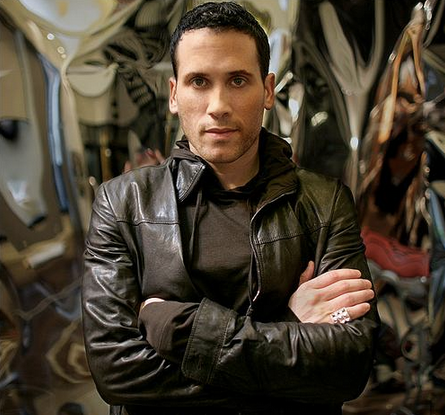
The dream is simple: get your product in the hands of celebrities or “influencers,” and they create a ripple effect that skyrockets you to fame and fortune.
What if Kim Kardashian tweets about you?
What if Hugh Jackman wears your custom shirts on the red carpet?
What if a top blogger includes you in a top-10 list?
What if you got a mention on The Office or another primetime show?
Sadly, sampling to “stars” seldom works out.
People who move the needle get a TON of stuff sent to them. The pic below is just part of my mail, and I’m not even a real celeb! Blurb and blog promotion requests received in one day, with the exception of one book:
So…how do YOU break through the noise?
This guest post will teach you. It’s written by Marc Ecko, founder of Marc Ecko Enterprises, a global fashion and lifestyle company. I wanted Marc to write this post because — in my opinion — he’s an expert at selling yourself without selling out. As CNBC put it, “Marc is living proof that you can be a marketing and business whiz and still be a true artist.”
Once a graffiti artist with no connections, Marc left the safety net of pharmacy school to start his own clothing company. Using hustle and creativity, he turned a $5,000 bag of cash into a global corporation worth hundreds of millions of dollars.
He created a lot of this success by repeatedly getting his products to impossible-to-reach icons (e.g. Spike Lee, Chuck D) and planning elaborate PR stunts (e.g. Air Force One graffiti hoax; buying Barry Bonds’ homerun record baseball and letting online votes determine its fate).
This post will explain his 10 rules — the do’s and don’ts — of his unique “swag bomb” approach to getting influencer attention. I agree with all of them.
Enjoy, replicate, and prosper…
ALSO: Marc will be answering questions in the comments, so leave your thoughts after the end of this post!
Enter Marc Ecko
Before Ecko was Ecko, it was just me, a suburban kid in New Jersey airbrushing stuff in my parents garage. In terms of hip hop, I was the quintessential outsider. I didn’t know anyone, I didn’t have any connections. All I knew was that I was passionate about my art, and that I wanted to make a business out of it.
In other words, I was in the exact position that basically every entrepreneur, author, and creative person in the world starts in. I had to make a name for myself–I had to crack in. I could only think of one way: giving stuff away for free to people who would like it. Taking action.
Over the years I perfected this strategy, using it to launch and build countless brands from Ecko Unltd to G Unit to Cut & Sew, Complex and Zoo York. Ecko, alone, has done billions of dollars in revenue since those days in the garage twenty years ago. Our collaboration with George Lucas and the iconic Star Wars brand was a direct result of this strategy. I’ll go to my grave proud of the fact that George Lucas actually said–and this is a quote–“No one has made STAR WARS cooler than ECKO.”

A lot of people think that mailing samples is just that–throwing some crap in the mail and hope it works. Well, that couldn’t be more wrong. A Swag Bomb, properly executed, is a work of art. When done right can generate massive amounts of PR, connections and access.
When done improperly, it ends up here…in the pile of orphan books at the New York Times. Or worse, it ends up in the trash can or lays their unopened. You’ve worked too hard to let that happen, to throw that work away because you made some simple mistakes.
So let’s go back to that garage. I’ll show you how swag bombs were instrumental in building the Ecko brand and then the lessons I’ve learned–trust me, I made a lot of mistakes–along the way.
The first person I ever tried to send one to was Kool DJ Red Alert. Back then he was one of, if not the, most dominant DJs in hip-hop, and Rolling Stone magazine would name him as one of the fifty most influential people in music. Every weekend night, in an era before iTunes and Spotify, everyone listened to Red Alert on the New York radio station 98.7 Kiss-FM, the audio bible of hip-hop.
I couldn’t wait until his Friday-night show. Red was famous for doing shout- outs. I had no patience for waiting on hold and doing the dial-up thing, so I went to my strong suit of communication: my art. During his radio show, I camped out at the Kinko’s and straight-up spammed his fax machine with “Echo Airbrushing” promos. Black-and-white pen-and-ink illustrations of MCs standing encircled in a rap cypher. Or images shot from the floor to the sky, showing MCs jumping across the stage. All the images were unapologetically self-promotion- al—self-referential—and clearly branded and signed “Echo.” (I actually have a photo of one of the hats still–check it out)
And then one Friday night I’m listening to 98.7 like always, drawing in my black book, and I hear something on the radio.
“I gotta shout out my man Echo for blessing me with this fly gear! Yo, he got the fresh airbrushed gear, the craze snapback hats! My man Echo Airbrushing, yeah, yeah, Big Up Lakewood, New Jersey, and my man Echo, artwork is crazy.”
Whoa, what!?
The shout-out tasted good. I wanted more. I didn’t get complacent and didn’t let it fizzle as a one-shot thing; I had an instinctive grasp of the power of inertia, so I doubled down and sent him more.
I knew that I was on the verge of something. I knew because it felt authentic. I could sense that the timing was right and that I needed to take it to the next level.
I hope these rules–many of which I learned the hard way–will help you do the same with your own efforts.
===
TEN RULES FOR BUILDING A SWAG BOMB
1. Never Send Directly to Someone’s Home
I’ve had that happen. It’s fucking creepy. Everyone has a business address, and in this day and age, they’re sufficiently accessible. No one likes to feel like you’ve violated their personal space–and if you do that, that negative feeling is associated with your product, thus defeating the purpose.
Even creepier? Sending actual bombs. Look, I know it is a “swag bomb”, but there is no swag in sending unsolicited items to a personal address, particularly when the items are disguised to look like explosives.
For example, if you’re sending out a book (as I did; more on this shortly), don’t send them to reporter’s homes. That would be creepy. I sent mine to their office address, through my publisher, like normal people would do.
The same goes for email addresses. Don’t find every single email address the person has ever listed and blast them all at once. Don’t scour for the “private” or “personal” email because you think they don’t check the main one listed on their contact form. It makes you seem desperate–and weird. Find their public email and make your pitch. If you do it well, it will work. If it doesn’t, the problem is your pitch…not where you’re pitching it.
2. Never Expect Your Intended Audience to Even See It
So make it good enough that even if it gets to only his or her lieutenant—which will often be the case—you still make a material impact. In other words, if you’re in the t-shirt business, don’t send one shirt. Send an enormous box fill. Make the delivery a big event.
My friend Ryan Holiday did the marketing for American Apparel and instead of sending some small package, he sent a crate. One of the bloggers uploaded a video on YouTube and it did 125,000 views. That’s crazy. Look at Pepperidge Farms, which overnighted a box of “Milano” cookies to a blogger who wrote about the cookie. The act was memorable enough that the resulting post on reddit scored Pepperidge Farms over 500,000 new views and fans. But even if that had never gone public, it was still a cool way to hook a fan up–and all they would have been out was a couple bucks.
Me, I seeded my brand with the bona fide artists and instigators of pop culture. The motivation wasn’t as simple as “I hope they wear this”; it came from a desire to educate them, to land on their aesthetic radar, and to build a literacy of who I was and what I was trying to accomplish. So even if the package doesn’t go all the way to the top, it’s still making waves where it matters.
3. Never Send Just the Stock Shit
Think deeply about what you will send them, and work hard at customizing the content so that the end user will recognize this as an amazing, highly personalized gift. And it’s just that—a gift—so…never have expectations beyond giving a gift.
Back in the day, I could quote Do the Right Thing and Mo’ Better Blues backward and forward, so I sent Spike Lee some gear too. I heard he had a new movie out—a biopic of Malcolm X—so I sent him a sweatshirt with a meticulously painted portrait of Malcolm X on it. Personalization is crucial. I must have spent two days on that one.
Spike Lee graciously sent me a thank-you note—an actual signed letter from Spike! Fucking! Lee!—and that felt good. “Ya-dig? Sho-nuff.”
Take HBO sending custom bags to promote premiere of “Liberace”. They featured items tying into the biopic of excess living and luxury to relevant journalists. Custom Moet & Chandon bottle, engraved necklaces, the works. They went crazy over the top because that’s Liberace. Something stock wouldn’t have made any sense.
Another fun bit of inspiration. Remember Woot.com’s “bag of crap” deal? The reason it was so fun? Every once in awhile somebody’s bag would be full of cash. You can bet the internet blew up every time that happened. You can create that reaction with your own products too. You can blow people’s minds with a surprise every now and then.
4. Never Have Expectations, as It’s Just a Gift
The joy and purpose has to come from the confidence that you did it; you took action. Not everyone will acknowledge receipt. That’s okay. The point is the send out a lot of these–eventually you’ll get one or two big connections that subsidize all the misses. After all, I didn’t just send to Red Alert, but also Public Enemy’s Chuck D. Q-Tip. KRS-ONE. Essentially, I sent packages to all the cultural pioneers who inspired me.
For my book Unlabel, I hand-packed 15 Ecko-branded white shopping bags with red paper inside. Inside each was a big white Ecko branded watch, an Ecko fragrance, the super sweet wireless speaker that looks like a black spray paint can, plus Ecko earbuds. The reporters I sent them to were likely expecting a t-shirt (or just a book in a plain envelope and instead got a Swag Bomb that said Ecko was much more than that. Even though we invested a couple hundred dollars in the package, I’m not going to be upset if they don’t write about it.
A swag bomb is not a contract, there are no guarantees. Even when it is a $50,000 swag bag at the Oscars. It’s all about the hope that if you send the right stuff and hit the right chord, magic will happen.
5. Never Handwrite Your Marketing Materials
It’s one thing to send a handwritten cover note (preferably a 6” x 4.5” stock postcard) that’s less than twenty words. Fine. But it’s something else to send an all-handwritten business proposal that looks like it came from Son of Sam. I don’t care how legible your writing is. Type.
Don’t think of this as sending “fan mail.” This is a professionally produced, hyper-customized presentation. When you send me (or anyone) a solicitation of your idea, or your product, or the marketing materials of who you are and what you’re trying to sell, work backward from the experience of cracking open the box from its taped seal.
6. Never Use Second-Hand Packaging Materials
A used Trapper Keeper folder— with maybe a sticker over the dents so that you pass it off as new—ain’t cutting it. Why should I take your idea seriously if you’re not even willing to make a quick trip to Staples? Presentation is everything.
For example, early on I helped my best friend Cale (an aspiring R&B singer) get a meeting with Michael Bivins (Biv) with one of my jackets. Biv, a member of New Edition and Bell Biv Devoe, was the Simon Cowell of early-1990s R&B; he had a knack for discovering young talent, taking chances, and making stars out of nobodies like three Philly kids who became Boyz II Men.
We went all out. I made the jacket in the Blue Room of my garage, using a canvas of Swarovski crystals I had copped from a rummage store. Black, pewter, red, and clear. I bedazzled the hell out of that thing, one crystal at a time. Then, I tucked the cassette of my best friend Cale, along with a note, in the left chest pocket. That’s what we really wanted him to see.
Same goes if you’re more established–don’t just have the warehouse or your manufacturer (or Amazon.com) send some package on your behalf. Be legit, handle it like it’s a work of art. Someone complained to Old Spice recently, so they unsolicitedly hooked the guy up. But look how professional it looks–it wasn’t a couple sticks of deodorant in a box. It looks legit–like they actually care.
7. Never Stalk
If you have a phone number or email of an executive assistant, fine, it’s okay to call once in advance and then again once in confirmation of receipt. (You can also send it with a certified receipt, so you know who signed for it, and when.) But don’t call repeatedly like some psycho. Not cool.
Look at all the gift bags they give out at SXSW each year. Can you imagine if taking one was an implicit contract with the companies to follow you on social media or beg you for favors? It’d be a nightmare. People would be afraid that taking a t-shirt was akin to signing your life away.
Treat handlers (assistant, publicist, manager, associate) with respect. Not only is this the right thing to do, but this could be the hand of the king—and they’ll later whisper into the king’s ear.
In fact, after you confirm the receipt, consider the ball to be in their court. Don’t do anything until they make the next move. Got it?
8. Never Forget to Include Your Name, Email, and Phone Number
Don’t presume that anyone is going to read a long letter. If the visual impact and the overall wraparound isn’t there, you’re dead. So make sure it looks good, feels good, and that it emotes your goals. And make it as clear as the sun who sent it. God-forbid you make a connection and then they don’t know what to do about it.
After we gave the jacket to Biv, we sat on pins and needles waiting. At three o’clock in the morning, the phone rang.
“Yo, is this Marc? This is Biv.” Biv’s signature gravelly voice.
“Hi, um, yeah, this is . . .” I tried to remember my name.
“I want to hook up with your man Cale. Tell him to be at the Sheraton in Red Bank in thirty minutes.”
Three thirty am. Cale didn’t chicken out. Cale jumped on a once-in-a-lifetime opportunity. Cale took action. Two weeks later, Biv signed Cale to his newly formed imprint on Motown Records called Biv 10 Records.
When you get, The Call, be ready to go. No matter the time of day.
9. Never Send a Picture of Yourself Fan-Boying Out
Again, creepy. Let the content and the high concept speak for you. Don’t send some weird headshot.
Don’t be the guys and girls in these photos. Don’t! Look how miserable (but patient) the celebs are. But that would immediately stop if the people followed up with “Now let me tell you about my awesome business idea.” That chance was blown.
If there ever was someone to fanboy over in my personal life, it was George Lucas. However, instead of sending strange photos of my star wars collection, I waited until I was near Lucas, and casually showed him my geeked-out Yoda BlackBerry case I had personally made, and we instantly had a good vibe. There is a time and place for fanboy-dom, and pre-pitch isn’t it. (Here I am with George–see how calm I am being? It was hard but I made it.)
10. Never Gush
Notable figures don’t like being fawned over. Be careful to whom you say—and how often you say— “I love you.” (Good rule for life in general.) Don’t tell them, “You are my idol.” Speak matter-of-factly, and acknowledge the traits or practices that you respect and admire.
When Barry Sanders scored a touchdown, he would casually toss the football back to the ref, shrugging, and living by the credo “Act like you’ve been there before.” That should be you.
Leave the gushing to them. After all, if you do it right, they’ll be so grateful or impressed by the gift that they’ll give you the treatment.
CONCLUSION
There is one reality every entrepreneur has to face. You’re always pitching. You never stop auditioning. Even for Spike, even Mark Zuckerberg, even for the president.
The Swag Bomb is part of that. Get your stuff–because it’s great–in the hands of as many important people as you can. Sweat and bleed and innovate to make that happen.
An authentic personal brand is more than just an idea. It’s not static. It’s not enough to say I have a brilliant idea and then lock it in your laptop. And it’s not enough to just talk about it, tweet about it, blog about it. Talk is cheap. An authentic, unique voice is a doer.
You will always keep pitching, and you will always have to deal with rejections. This doesn’t mean you should give up; it means you’re human and you have a pulse.
It’s tough to find famous examples of companies, artists, or individuals who didn’t get there in some way with excellent presentation and artistry in bringing in important early influencers and adopts.
The more telling example is the thousands of companies and millions of people you haven’t heard of: the artists, entrepreneurs, creators, and would-be instigators who talked a good game but never put themselves or there or did the work to get noticed.
Afterword by Tim
The “Swag Bomb” approach has many applications. Instead of customization, you can choose a unique venue, as I did when I gave away 500+ copies of The 4-Hour Chef at a TechCrunch Disrupt event, knowing that bloggers and other media would be there. It was unexpected, and the copies disappeared within hours, leading to tons of social media chatter when it mattered (during launch).
Last but not least, it often pays to NOT go for the most popular celebs, Twitter accounts, or otherwise. Remember the bar scene in A Beautiful Mind? On a 1-10 scale, 10 being the most trafficked, three or four 7 bloggers featuring you is far better — and easier/faster to achieve — than you obsessing over landing one 10 blogger.
For more tips and tricks for how to jump from niche to mega-mainstream, I highly recommend you check out Marc’s first book, Unlabel: Selling You Without Selling Out.
Marc will also be answering questions in the comments, so please share your questions below! If you have any sample-sending success stories of your own, I’d love to hear them.






September 23, 2013
You’d Like to Be an Angel Investor? Here’s How You Can Invest In My Deals…

Most deals get done in informal settings. Now, I’m inviting you to join me. (Photo: Russell Yip)
Please note that my syndicate investing in Shyp has now closed. You can still back me on AngelList to gain priority access to future deals. More updates will be posted here later in the round.
On September 23, 2013 (that’s today), the world of startup financing changes forever. It’s a truly historic moment.
Previously, I couldn’t publicly share deals with you. Now, thanks to an unprecedented legal change, I can offer a portion of my start-up investments to any of you who qualify as “accredited investors.”
Previously, you had to be part of a small club to see such deals. Not any more.
Previously, you might even need to be in Silicon Valley, drinking wine and having coffees around the clock, to see good deals before they filled up. No longer.
Starting today, I’ll share some of my favorite deals with you, beginning with a start-up called Shyp.
Notable companies I’ve advised include Uber (pre-Series-A), Evernote, Automattic (WordPress.com), Shopify, and TaskRabbit, among others. Early investments include Twitter, Facebook, Reputation.com, etc.
In this case, I used a “Spearhead Capital” blog post to my ~1.4M monthly blog readers to find promising startups. Nearly 400 companies applied, many of which are producing millions in revenue. Out of all of them, and with the help of Naval Ravikant (CEO/co-founder of AngelList) to interview finalists, I chose Shyp.
Shyp is the fastest and easiest way to ship packages. More on that shortly.
Investing alongside me–and potentially you–in this round are:
David Marcus (President of PayPal)
Brian McClendon (Founder of Google Earth)
Daymond John (Founder of FUBU, Shark on ABC’s “Shark Tank”)
Joshua Schachter (Founder of Delicious, Tasty Labs)
Aaron Batalion (Co-founder of LivingSocial)
Homebrew (Hunter Walk and Satya Patel)
Naval Ravikant (CEO/co-founder of AngelList)
Scott Belsky (Founder and CEO of Behance)
Sherpa Ventures (Scott Stanford & Shervin Pishevar)
Antonio J. Gracias (Board Member at Tesla and SolarCity)
XG Ventures (Andrea Zurek and Pietro Dova)
Osama Bedier (Former head of Google Wallet)
…and more
So, how can you join us?
Before I tell you, remember:
Startups are speculative, and this is gambling. You shouldn’t invest anything you’re not comfortable kissing goodbye. Treat it as casino money.
If you are going to invest in startups despite this high risk, plan on building a portfolio of dozens, very slowly and carefully. This should be just one of many. Read more on approach here.
The Short Version
If you’d like to invest in Shyp, simply click here. A description of the company is in “The Longer Version” below.
You’ll need to set up an AngelList profile (free), and the minimum investment is $2,500. We’re only able to accept $250,000 from everyone.
For more on the team and concept of Shyp, click here.
If you miss this one, not to worry–you can automatically join my deals in the future, which puts you first in line next time.
Can’t invest right now? No worries. If relevant, I’d love for your to consider any of the below actions. Shyp and I would really appreciate it!
- Apply to be a Shyp Hero (Heroes are Shyp’s drivers). Click here.
- Apply for a job on Shyp’s core team. Click here.
- Interview the co-founders of Shyp: Kevin, Josh, and Jack. They’re clever gents. Just email: founders at shyp dot com.
- Tell Shyp which city you live in so they can launch there before others!
The Longer Version
I’m putting my name and network behind Shyp and personally investing $25,000. I’ll also be providing oversight and advising the company on product/conversion optimization, national launch strategy, etc.
I’m using a new AngelList feature called “Syndicates” to share my $250,000 allocation of Shyp.
Unlike venture capitalists (VCs), I am charging zero management fees. If you don’t win, I don’t make a dime. If you invest alongside me, the only expense is a 20% “carry” (roughly 20% of the profits) if there’s a good outcome.
DESCRIPTION OF SHYP
Shyp is the fastest and easiest way to ship packages.
Through the Shyp iPhone app, you take a photo of what you want to send, specifying destination and pick-up time. You’re done.
A “Shyp Hero” (driver) arrives at your home or office at the specified time, takes your unpackaged item away to be packaged, then sends it on its way via the optimal carrier (i.e., Fedex, UPS, etc.). Shyp automatically optimizes for speed and cost, and Shyp charges no more than Post Office prices, plus a $5 pickup fee for sending solo items. If you send more than one item, the company waives the $5 pickup fee.
More on how this works below the video.
I have confidence in the team, and here’s why I love the model:
- Recurring revenue. It has a frequent use case, just like Uber and Evernote (again, both of which I’ve advised). Millions of people can use Shyp on a weekly or daily basis.
- It’s simple and solves a real problem. Do you enjoy going to the post office or UPS store? Scheduling pickups that require you to be available for 3-6 hours? Of course not. Shyp makes fixing all that as easy as snapping a picture. And they package everything for you. No more wasted afternoons.
- It has unusually high margins. Shyp matches USPS retail prices, but by taking a volume discount from carriers and utilizing regional couriers (that end-users cannot), Shyp can maintain high profit margins. Using OnTrac, as one example, is 75% cheaper than USPS.
- It’s tackling the “first mile” problem, not the “last mile” problem. Lots of companies are focused on same-day delivery from retailers to consumers: the last mile. It’s a crowded battlefield of a market. But what about the burden of packaging up shipments from homes and offices? This “first mile” problem is enormous, and the market is neglected. Shyp aims to own it.
How to Get In First
Would you like first access to my future deals, right alongside my close friends?
To see things before I post them on the blog, you can automatically back me on AngelList, as Naval (CEO of AngelList) and others are doing. Click here for more details. This will ensure you don’t miss anything.
###
DISCLAIMERS — DON’T SKIP:
Startups make big plans a lot, and most don’t follow them. Shyp might run out of money; customers might not like using a third party to ship things; UPS, Fedex, or some upstart could start competing; or the team could simply fall apart tomorrow. Any statements about their future plans, margins, etc., are pure speculation on my part. That’s why startup investing is very risky, so again: don’t invest anything you aren’t prepared to write off 100%. Last but not least, I’m not necessarily planning on sending frequent updates or notices of Shyp’s change in plans (if any), as startups change on a weekly or daily basis.








